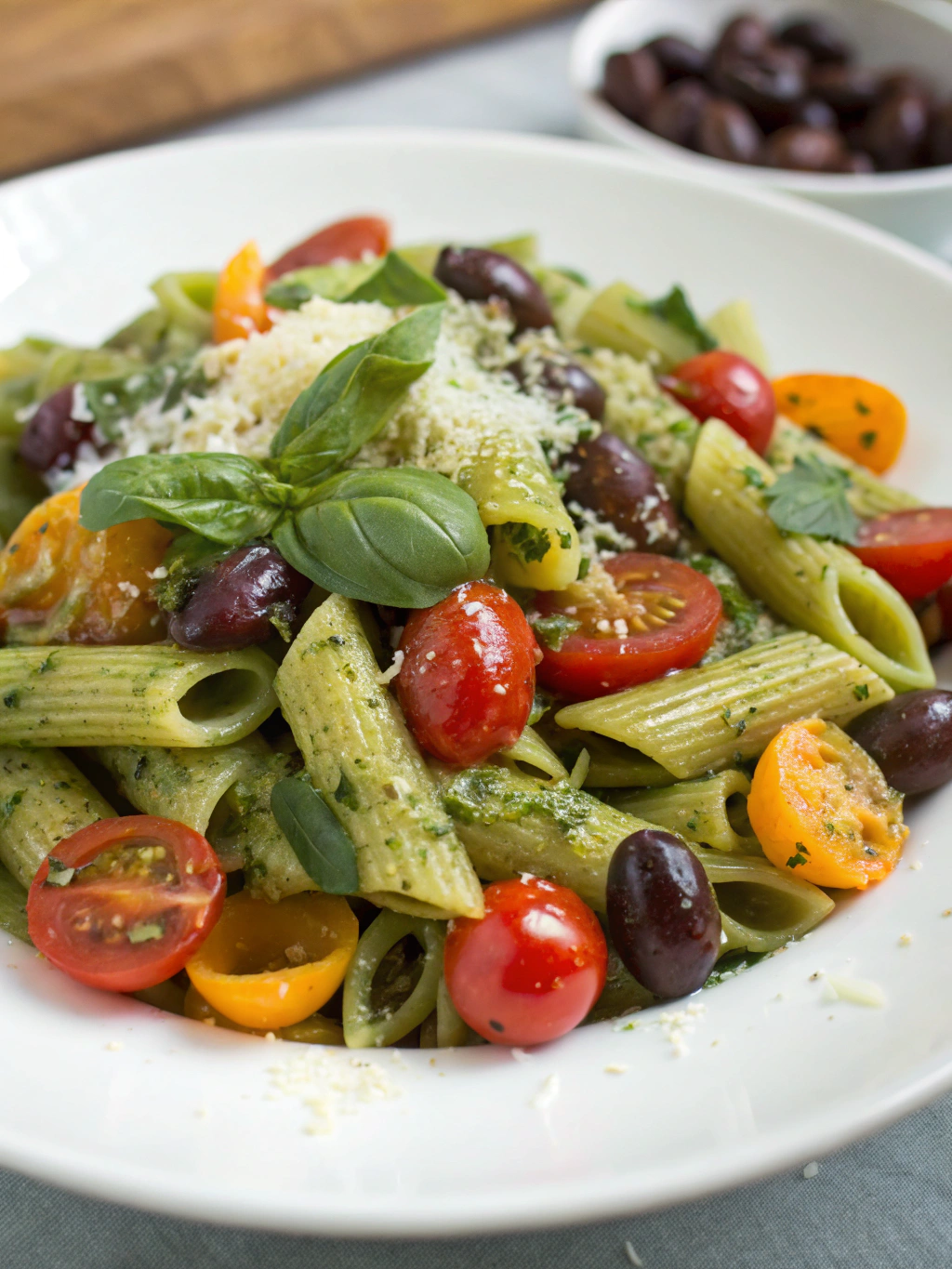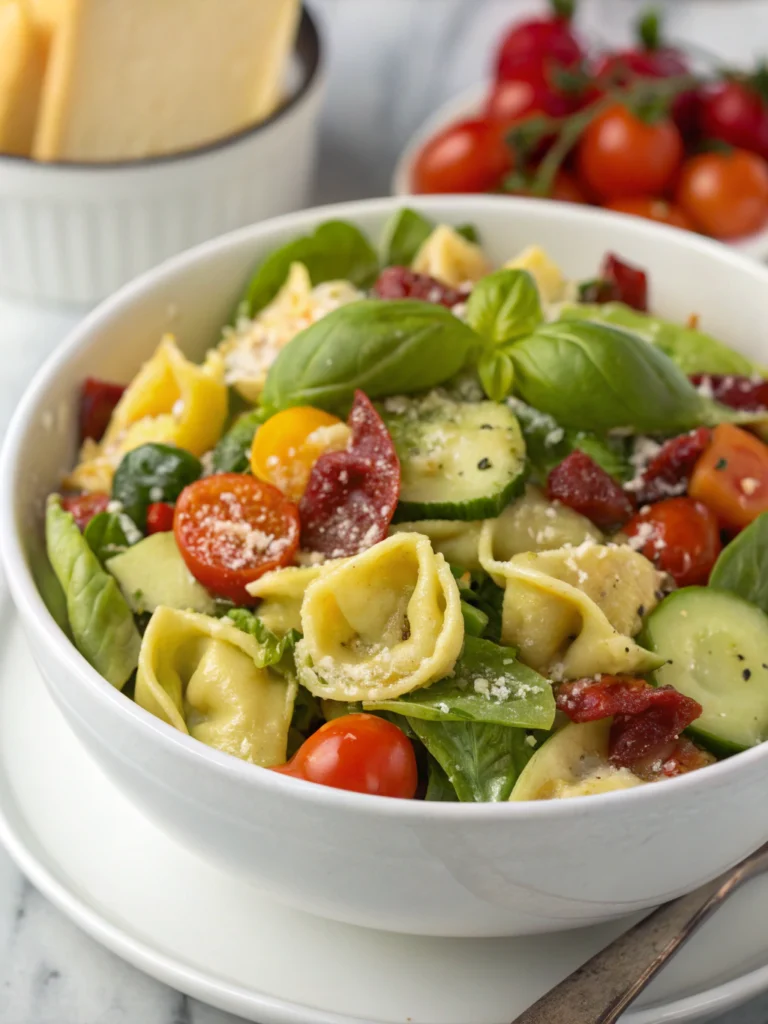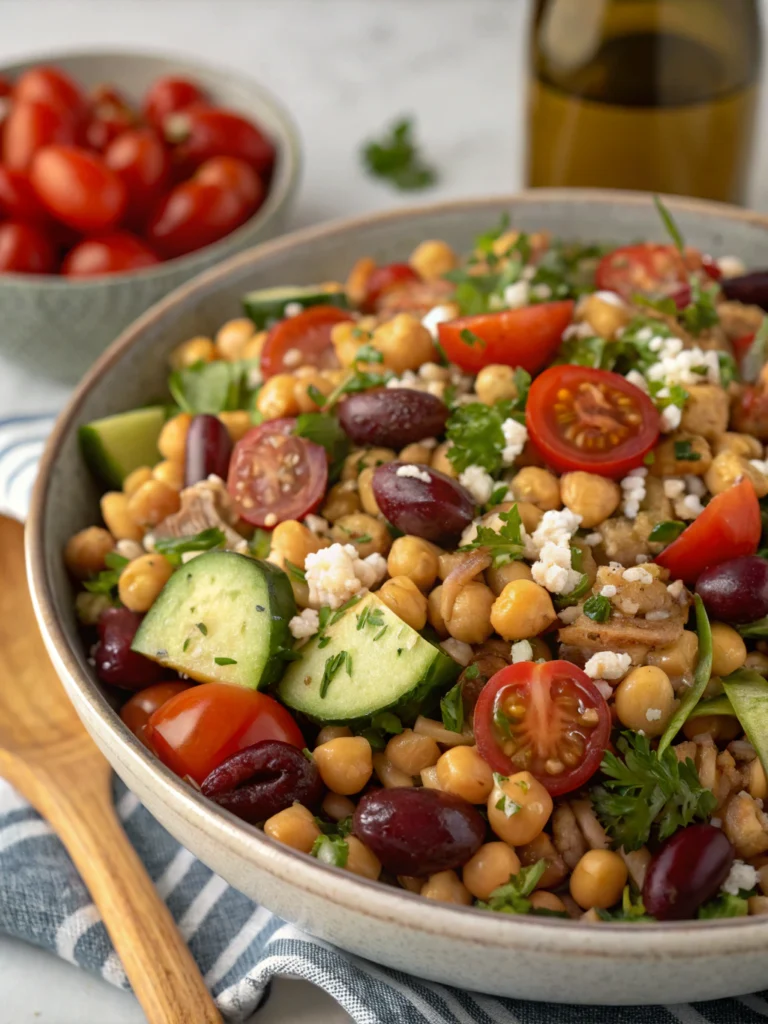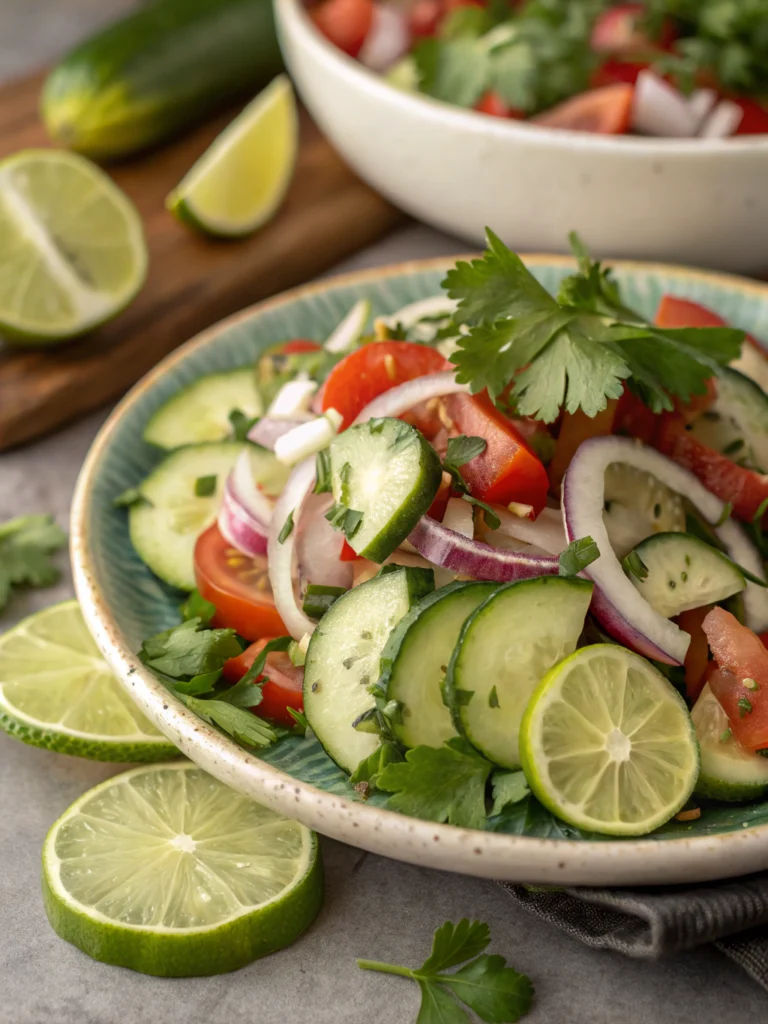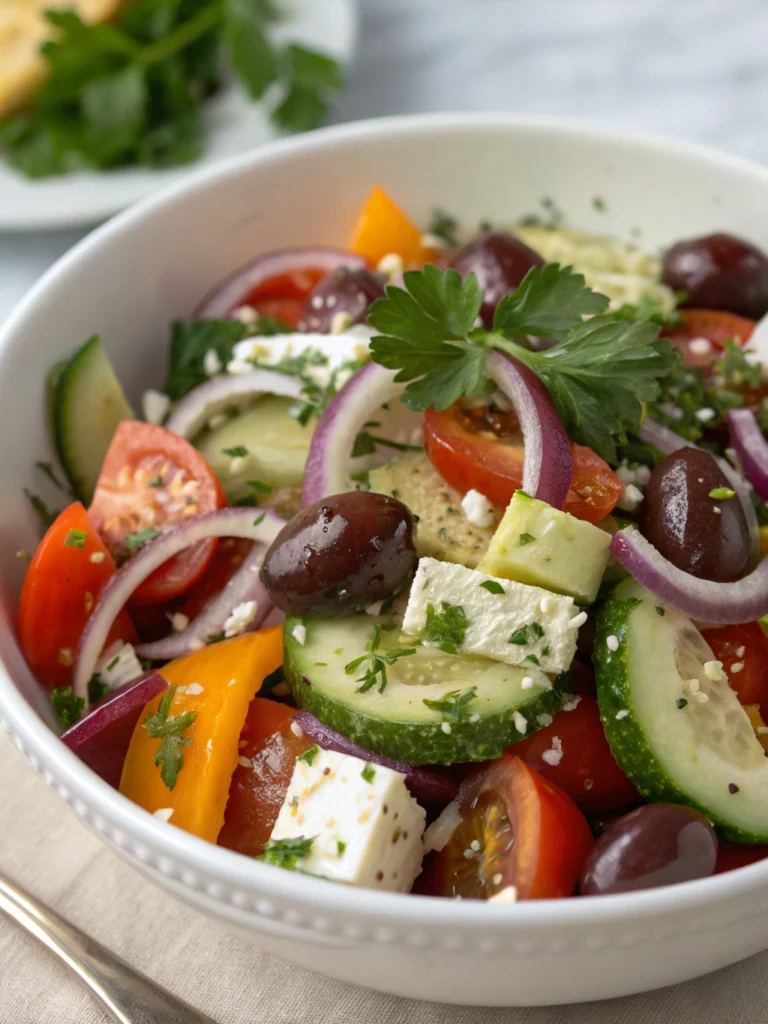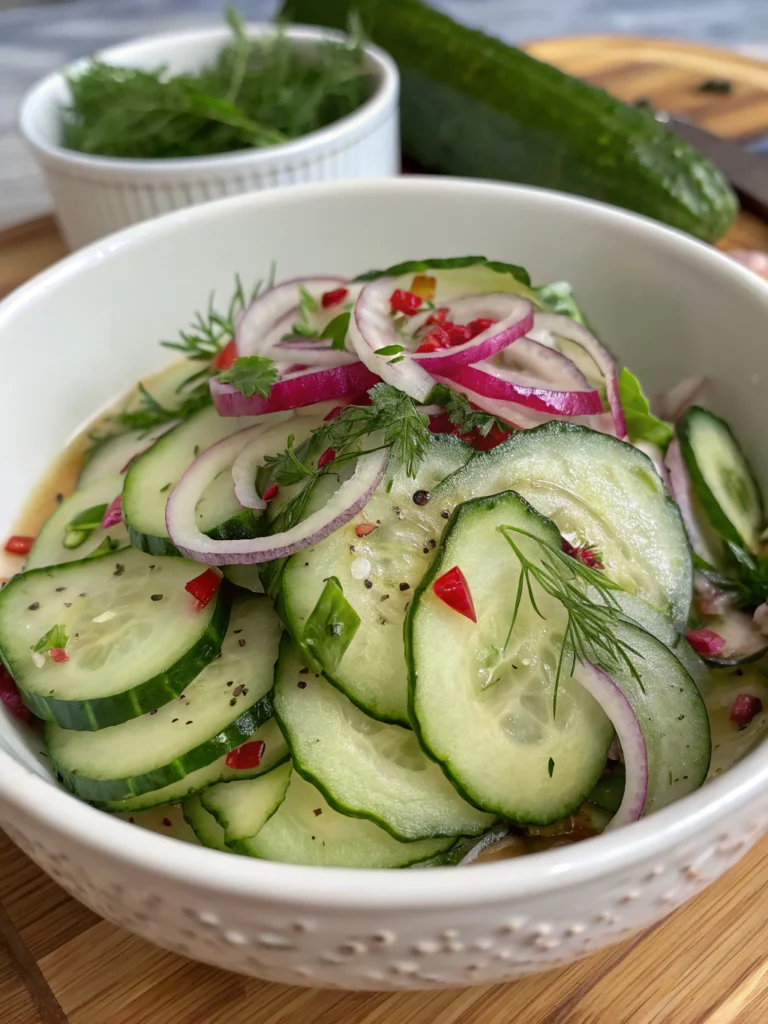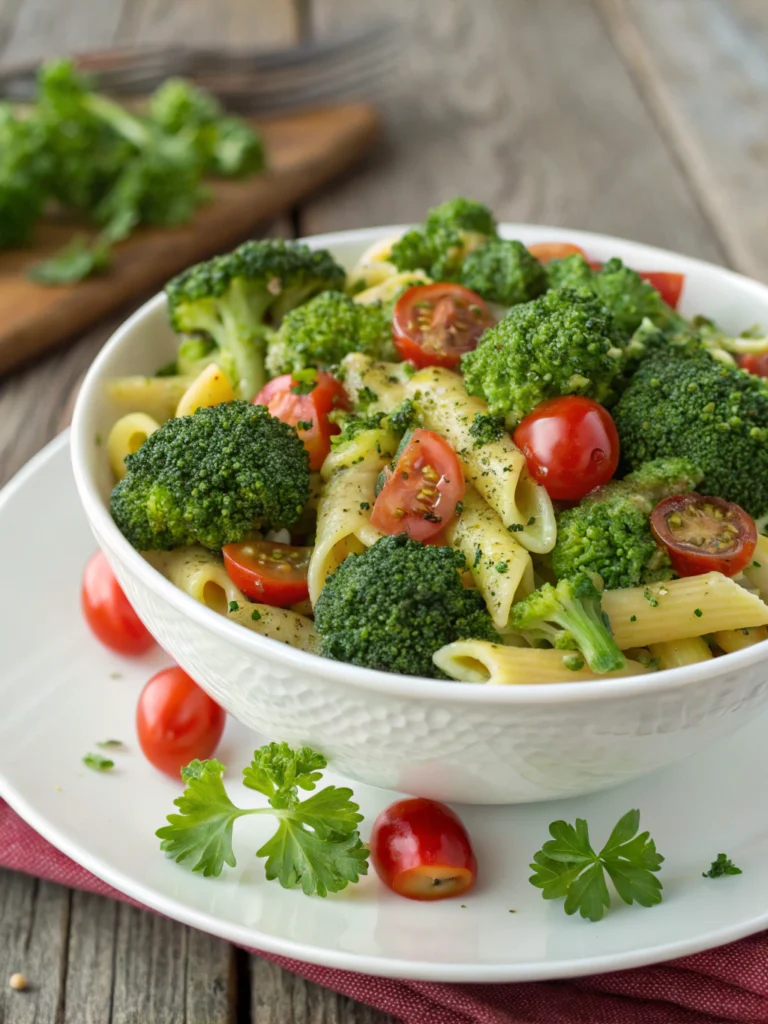Pesto Pasta Salad
A vibrant, flavor-packed summer dish combining al dente pasta, homemade basil pesto, juicy cherry tomatoes, and fresh mozzarella. Perfect for picnics, potlucks, or easy weeknight dinners. Ready in just 30 minutes and sure to become a family favorite!
Easy Pesto Pasta Salad Recipe
There’s something magical about the combination of fresh basil pesto coating perfectly cooked pasta, punctuated with bursts of sweet cherry tomatoes and creamy mozzarella pearls. This Pesto Pasta Salad brings together the bright, herbaceous flavors of summer in a dish that’s simultaneously simple and sophisticated.
Whether you’re looking for a show-stopping side for your next backyard barbecue or a refreshing main course on a warm evening, this versatile pasta salad delivers incredible flavor with minimal effort. Traditionally enjoyed during summer months when basil is abundantly fresh, this recipe has become a year-round staple in many homes thanks to the accessibility of quality ingredients in all seasons.
THIS RECIPE:
- Features a homemade basil pesto that’s miles above store-bought versions
- Requires just 25 minutes of active preparation time
- Can be made ahead and tastes even better the next day
- Easily customizable with your favorite add-ins
| Recipe Details | Information |
|---|---|
| Prep Time | 15 minutes |
| Cook Time | 10 minutes |
| Total Time | 25 minutes |
| Servings | 6-8 portions |
| Yield | Approximately 10 cups |
This Pesto Pasta Salad recipe strikes the perfect balance between ease and elegance. What makes it truly special is the harmonious blend of textures—tender pasta, creamy cheese, and juicy tomatoes—all unified by a vibrant pesto dressing that clings beautifully to every bite. Even kitchen novices can create this impressive dish with confidence, making it perfect for both everyday meals and special gatherings.
Ingredients for Pesto Pasta Salad
The secret to an exceptional Pesto Pasta Salad lies in the quality of your ingredients. Since this dish features relatively few components, each one contributes significantly to the final flavor profile. Opt for the freshest produce and highest quality pasta you can find to elevate this simple recipe to something truly special.
For the Pasta Salad:
- 1 pound (16 oz) short pasta (fusilli, rotini, or farfalle work best)
- 2 cups cherry tomatoes, halved
- 8 oz fresh mozzarella pearls, drained
- 1/2 cup pitted Kalamata olives, halved
- 1/4 cup red onion, finely diced
- 1/4 cup toasted pine nuts
- 1/4 cup freshly grated Parmesan cheese
- Salt and freshly ground black pepper, to taste
For the Homemade Basil Pesto:
- 2 cups fresh basil leaves, packed
- 1/2 cup freshly grated Parmesan cheese
- 1/3 cup pine nuts, toasted
- 3 garlic cloves, peeled
- 1/2 cup extra virgin olive oil
- 1 tablespoon fresh lemon juice
- 1/4 teaspoon salt
- 1/8 teaspoon freshly ground black pepper
| Ingredient Category | Recommended Quantity | Quality Tips |
|---|---|---|
| Pasta | 1 pound (16 oz) | Choose bronze-die cut pasta for better sauce adherence; Italian-made brands often have superior texture |
| Fresh Produce | 2 cups cherry tomatoes, 1/4 cup red onion, 2 cups basil | Select deeply colored tomatoes with firm flesh; basil should be vibrant green with no dark spots |
| Cheese | 8 oz fresh mozzarella, 1/2 cup + 1/4 cup Parmesan | Use buffalo mozzarella for creamier texture; Parmigiano-Reggiano adds authentic nutty flavor |
| Nuts | 1/3 cup + 1/4 cup pine nuts | Toast slightly before using to enhance flavor; store in refrigerator to prevent rancidity |
| Oil & Acid | 1/2 cup olive oil, 1 tbsp lemon juice | Choose cold-pressed extra virgin olive oil for best flavor; use fresh lemon juice, never bottled |
How to Make Pesto Pasta Salad
Creating the perfect Pesto Pasta Salad is all about timing and technique. The process can be broken down into three main components: cooking the pasta properly, preparing a vibrant homemade pesto, and combining everything with fresh ingredients for maximum flavor impact. The secret is allowing enough time for the flavors to meld while maintaining the integrity of each ingredient.
Step 1: Cook the Pasta
- Bring a large pot of water to a rolling boil.
- Add 1-2 tablespoons of salt to the water (it should taste like seawater).
- Add pasta and cook according to package directions until al dente (typically 8-10 minutes).
- Reserve 1/4 cup of pasta cooking water before draining.
- Drain pasta and rinse briefly with cold water to stop the cooking process.
- Transfer pasta to a large mixing bowl and toss with 1 tablespoon olive oil to prevent sticking.
Step 2: Make the Homemade Pesto
- In a food processor, combine basil leaves, garlic, and pine nuts.
- Pulse until coarsely chopped, about 10 pulses.
- Add the Parmesan cheese, salt, and pepper, then pulse again to combine.
- With the processor running, slowly drizzle in the olive oil through the feed tube until the mixture is smooth and emulsified.
- Add lemon juice and pulse briefly to incorporate.
- Taste and adjust seasonings as needed.
Step 3: Assemble the Pasta Salad
- Add the homemade pesto to the cooled pasta and toss thoroughly to coat.
- If the pesto seems too thick, add 1-2 tablespoons of the reserved pasta water to help it adhere to the pasta.
- Gently fold in the halved cherry tomatoes, mozzarella pearls, olives, and diced red onion.
- Sprinkle with toasted pine nuts and additional Parmesan cheese.
- Season with salt and freshly ground black pepper to taste.
- Allow the salad to rest for at least 15 minutes before serving to let flavors meld.
Tips for Making Pesto Pasta Salad
Elevating your Pesto Pasta Salad from good to unforgettable comes down to mastering a few key techniques and understanding the nuances of the ingredients.
- Cook pasta properly: Always salt your pasta water generously and cook pasta just until al dente. Overcooking will result in a mushy salad.
- Cool pasta strategically: A quick rinse stops cooking but don’t cool pasta completely before adding pesto—warm pasta absorbs flavors better.
- Balance your pesto: Adjust the consistency of your pesto with pasta water rather than additional oil for a silky texture that coats evenly.
- Layer your flavors: Add a portion of the Parmesan directly to the pasta before the pesto for depth of flavor.
| Technique | Recommendation | Why It Matters |
|---|---|---|
| Pasta Selection | Short, textured varieties with ridges or twists | Better pesto adhesion and easier eating experience |
| Pasta Cooking | Cook until precisely al dente (firm to the bite) | Maintains texture when mixed with other ingredients |
| Pesto Making | Process ingredients in proper order: herbs/nuts first, then cheese, then oil | Creates proper emulsion and preserves bright color |
| Ingredient Layering | Add pesto to pasta before other ingredients | Ensures even distribution of flavor throughout the salad |
Pro tip: To maintain the vibrant green color of your pesto, blanch the basil leaves for 5-10 seconds in boiling water, then immediately plunge into ice water before drying thoroughly and proceeding with your recipe. This quick step deactivates the enzymes that cause browning.
Make-Ahead Instructions
One of the many virtues of Pesto Pasta Salad is its make-ahead potential. In fact, allowing the ingredients to mingle for a few hours often results in a more flavorful final dish, making this an ideal recipe for busy hosts or meal preppers.
For best results, you can prepare components separately up to 2 days in advance:
Pasta: Cook, cool, and store in an airtight container with a small drizzle of olive oil to prevent sticking. Refrigerate for up to 2 days.
Pesto: Make the complete pesto up to 2 days ahead. Store in an airtight container with a thin layer of olive oil on top to prevent oxidation and darkening. Refrigerate until needed.
Prepped vegetables: Halve tomatoes, dice onions, and prepare olives up to 1 day ahead. Store separately in the refrigerator.
When ready to assemble, bring the pesto to room temperature for about 15 minutes, then toss with the pasta (if pasta is cold from refrigeration, you may need to microwave it for 20-30 seconds first). Add the remaining ingredients and allow to sit for at least 15 minutes before serving.
For a completely assembled salad, you can prepare the entire dish up to 8 hours in advance, keeping it refrigerated until about 30 minutes before serving. Save the pine nuts to add just before serving to maintain their crunch.
Storing Leftovers
Properly stored Pesto Pasta Salad makes for excellent leftovers, with flavors that often intensify overnight. Follow these guidelines to maintain food safety and optimal taste:
- Transfer leftover pasta salad to airtight containers within 2 hours of serving.
- Refrigerate promptly at 40°F (4°C) or below.
- Properly stored, Pesto Pasta Salad will keep for 3-4 days in the refrigerator.
- Glass containers work best for storage as they won’t absorb flavors or stain from the pesto.
- If the pasta seems dry when serving leftovers, revive it with a small drizzle of olive oil and a squeeze of fresh lemon juice.
When serving leftover pasta salad, remove from the refrigerator about 20 minutes before eating to take the chill off and allow flavors to wake up. Give it a gentle toss to redistribute the dressing and ingredients.
Pro tip: If you know you’ll have leftovers, reserve a small portion of the fresh pesto separately. When ready to enjoy the leftovers, stir in a spoonful of the reserved pesto to instantly brighten both the color and flavor.
Freezing Pesto Pasta Salad
While Pesto Pasta Salad is at its absolute best when fresh, you can freeze components separately for future use. The complete assembled salad is not ideal for freezing due to the texture changes in fresh vegetables and cheese, but here’s how to approach freezing elements of this dish:
Freezing Homemade Pesto:
- Make pesto as directed, omitting the cheese (add after thawing).
- Pour pesto into ice cube trays, filling each cavity about 3/4 full.
- Freeze until solid, then transfer pesto cubes to a freezer-safe bag.
- Label with the date and freeze for up to 3 months.
- To use, thaw needed amount in refrigerator overnight or at room temperature for 1-2 hours.
- Stir in freshly grated Parmesan cheese after thawing.
Freezing Cooked Pasta:
- Cook pasta as directed, but reduce cooking time by 1-2 minutes (it should be slightly firmer than al dente).
- Drain and rinse with cold water to stop cooking.
- Toss with a light coating of olive oil to prevent sticking.
- Spread on a baking sheet and freeze until firm, about 1 hour.
- Transfer frozen pasta to freezer bags and store for up to 1 month.
- When ready to use, thaw in refrigerator and bring to room temperature before combining with fresh pesto and other ingredients.
For best quality, I recommend freezing only the pesto and preparing the pasta and fresh components as needed. The frozen pesto can be a wonderful time-saver and will retain most of its vibrant flavor.
Serving Suggestions
A versatile Pesto Pasta Salad can shine as both a side dish and a main course, depending on how you serve it and what you pair it with. Here are some suggestions to make your pasta salad the star of any meal:
As a Main Course:
- Serve with grilled shrimp or sliced grilled chicken on top for added protein
- Pair with a crusty artisan bread and good quality olive oil for dipping
- Accompany with a light soup like gazpacho in summer or tomato bisque in cooler months
- Serve with a simple green salad dressed with lemon vinaigrette for a complete meal
As a Side Dish:
- Serve alongside grilled meats such as steak, Italian sausages, or lamb chops
- Pair with roasted or grilled vegetables for a vegetarian-friendly spread
- Offer as part of an antipasto platter with cured meats, additional cheeses, and marinated vegetables
- Include in a picnic or potluck menu alongside sandwiches, fruit, and desserts
Beverage Pairings:
- Crisp white wines like Pinot Grigio or Sauvignon Blanc complement the herbal notes of the pesto
- For non-alcoholic options, sparkling water infused with lemon or cucumber offers refreshing contrast
- Light Italian lagers or pale ales work well for beer enthusiasts
Serve the Pesto Pasta Salad slightly chilled but not cold from the refrigerator—about 15-20 minutes at room temperature allows the flavors to fully express themselves. For an elegant presentation, serve in a large, shallow bowl garnished with fresh basil leaves, a drizzle of high-quality olive oil, and a few whole toasted pine nuts.
FAQ
Can I use store-bought pesto instead of making it homemade?
Yes, you can substitute about 3/4 cup store-bought pesto for convenience. Look for refrigerated varieties rather than shelf-stable options for better flavor. For the best results, enhance store-bought pesto with 1 tablespoon fresh lemon juice and 2 tablespoons freshly grated Parmesan cheese to brighten the flavors.
What can I substitute for pine nuts if I have allergies or can’t find them?
Walnuts, almonds, or pistachios make excellent substitutes for pine nuts in both the pesto and as garnish. Sunflower seeds offer a nut-free alternative that still provides the necessary texture. Toast whatever substitute you choose to enhance the flavor before incorporating into your recipe.
My pesto turned dark after storing it. Is it still good to eat?
Yes, it’s still perfectly safe to eat. Darkening occurs due to oxidation when basil is exposed to air. This is a natural process that doesn’t affect flavor. To prevent this in the future, place plastic wrap directly on the pesto’s surface before sealing the container, or add a thin layer of olive oil on top to create a barrier against oxygen.
Can I make this recipe gluten-free?
Absolutely! Simply substitute your favorite gluten-free pasta. Rice, corn, or quinoa-based pastas work well. Cook according to package directions, but check frequently as gluten-free varieties often have different cooking times. You may need to add a little extra pesto as some gluten-free pastas absorb more sauce.
Why is my pasta salad dry the next day?
Pasta naturally absorbs sauce as it sits. For make-ahead Pesto Pasta Salad, consider these solutions: 1) Reserve about 1/4 cup of the pesto and add it to the salad just before serving, 2) Add a splash of olive oil and a squeeze of lemon juice to refresh leftovers, or 3) Make the initial pesto slightly thinner by adding an extra tablespoon of olive oil or pasta cooking water.

